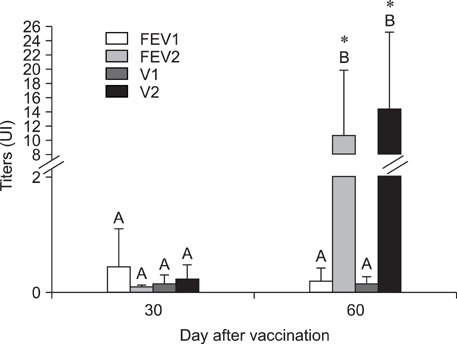J Vet Sci.
2008 Dec;9(4):433-435. 10.4142/jvs.2008.9.4.433.
Efficiency of Matricaria chamomilla CH(12) and number of doses of rabies vaccine on the humoral immune response in cattle
- Affiliations
-
- 1Universidade do Oeste Paulista-UNOESTE, Pos-graducao em Ciencia Animal, Presidente Prudente-SP, CEP 19067-175, Brazil. reis.lsls@gmail.com
- 2Secao de Raiva do Instituto Butantan, Sao Paulo-SP, CEP 05503-900, Brazil.
- 3Universidade do Oeste Paulista, UNOESTE, Laboratorio de Medicina Veterinaria Preventiva, Presidente Prudente-SP, CEP 19067-175, Brazil.
- 4Agencia Paulista de Tecnologia dos Agronegocios, Presdente Prudente, Sao Paulo, CEP 19100-000, Brazil.
- 5Universidade Estadual Paulista Julio de Mesquita Filho-UNESP/FMVZ, Departamento de Reproducao Animal e Radiologia, Botucatu, Sao Paulo, CEP 18618-000, Brazil.
- KMID: 1104922
- DOI: http://doi.org/10.4142/jvs.2008.9.4.433
Abstract
- This study evaluated the effect of Matricaria chamomilla and vaccination frequency on cattle immunization against rabies. Four groups (n = 15 /group) were treated with or without Matricaria chamomilla CH(12) and vaccinated with one or two doses of rabies vaccine (30 day interval). No effect of chamomile was found on cattle immunization against rabies; however, antibody titers were protective in cattle vaccinated twice, while 93.3% of cattle vaccinated only once had titers under 0.5 UI/ml after 60 days. In conclusion, the use of chamomile did not alter the humoral immune response in cattle, and two vaccine doses are suggested for achieving protective antibody titers.
Keyword
MeSH Terms
Figure
Reference
-
1. Albas A, Pardo PE, Bremer-Neto H, Gallina NMF, Mourão Fuches RM, Sartori A. Vacinação anti-rábica em bovinos: comparação de cinco esquemas vacinais. Arq Inst Biol. 2005. 72:153–159.2. Amirghofran Z, Azadbakht M, Karimi MH. Evaluation of the immunomodulatory effects of five herbal plants. J Ethnopharmacol. 2000. 72:167–172.
Article3. Banzatto DA, Kronka SN. Experimentação Agrícola. 1995. 3rd ed. Jaboticabal: Funep;247.4. Coleman PG, Fèvre EM, Cleaveland S. Estimating the public health impact of rabies. Emerg Infect Dis. 2004. 10:140–142.
Article5. Gharagozloo M, Ghaderi A. Immunomodulatory effect of concentrated lime juice extract on activated human mononuclear cells. J Ethnopharmacol. 2001. 77:85–90.
Article6. Giometti J, Chiacchio SB, Albas A, Pardo PE, Bremer-Neto H, Giometti AI, Reis LSLS. Influência da suplementação com crômio na resposta imune humoral anti-rábica em Bovinos. Arq Inst Biol. 2006. 73:421–427.
Article7. Hankins DG, Rosekrans JA. Overview, prevention, and treatment of rabies. Mayo Clin Proc. 2004. 79:671–676.
Article8. Kotait I, Gonçalves CA, Peres NF, Souza MCAM, Targueta MC. . Controle da Raiva dos Herbívoros. Manual Técnico 1. 1998. São Paulo: Instituto Pasteur;1–11.9. Lodmell DL, Smith JS, Esposito JJ, Ewalt LC. Cross-protection of mice against a global spectrum of rabies virus variants. J Virol. 1995. 69:4957–4962.
Article10. Piza AT, Pieri KMS, Lusa GM, Caporale GMM, Terreran MT, Machado LA, Zanetti CR. Effect of the contents and form of rabies glycoprotein on the potency of rabies vaccination in cattle. Mem Inst Oswaldo Cruz. 2002. 97:265–268.
Article11. Queiroz da Silva LH, Cardoso TC, Perri SHV, Pinheiro DM, Carvalho C. Pesquisa de anticorpos anti-rábicos em bovinos vacinados da região de Araçatuba, SP. Arq Inst Biol. 2003. 70:407–413.12. Sihvonen L, Kulonen K, Neuvonen E. Immunization of cattle against rabies using inactivated cell culture vaccines. Acta Vet Scand. 1994. 35:371–376.
Article13. Smith JS, Yager PA, Baer GM. Meslin FX, Kaplan MM, Koprowski H, editors. A rapid fluorescent focus inhibition test (RFFIT) for determing rabies virus-neutralizing antibody. Laboratory Techniques in Rabies. 1996. 4th ed. Geneva: World Health Organization;181–192.14. Zalan E, Wilson C, Pukitis D. A microtest for the quantitation of rabies virus neutralizing antibodies. J Biol Stand. 1979. 7:213–220.
Article
- Full Text Links
- Actions
-
Cited
- CITED
-
- Close
- Share
- Similar articles
-
- Immunogenicity of an inactivated rabies vaccine for animals derived from the recombinant ERAGS strain
- Matricaria chamomilla CH12 decreases handling stress in Nelore calves
- Cellular immune response following pre-exposure and postexposure rabies vaccination by intradermal and intramuscular routes
- A genetically modified rabies vaccine (ERAGS) induces protective immunity in dogs and cattle
- Antibody Response in Cattle and Guinea Pigs Inoculated with Rabies Vaccines


